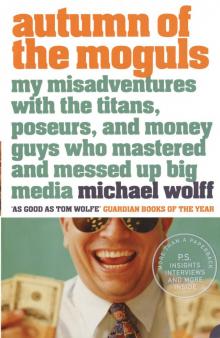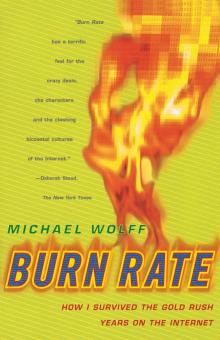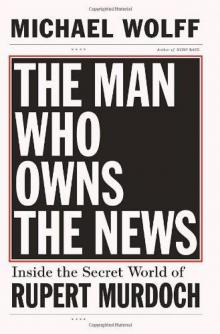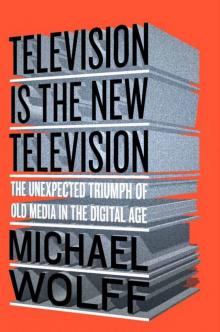- Home
- Michael Wolff
Burn Rate
Burn Rate Read online
Thank you for downloading this Simon & Schuster eBook.
* * *
Join our mailing list and get updates on new releases, deals, bonus content and other great books from Simon & Schuster.
CLICK HERE TO SIGN UP
or visit us online to sign up at
eBookNews.SimonandSchuster.com
Contents
Preface
One: A Diamond As Big As the Ritz
Two: How It Got to Be a Wired World
Three: The Board Meeting
Four: The Art of the Deal
Five: Internet Time
Six: Something for Nothing
Seven: A Working Relationship
Eight: The Twenty-First-Century Corporation
Nine: Exit Strategy
Ten: Past as Prologue
Acknowledgments
For Our Children
Elizabeth, Susanna, and Steven
“How many people have you got on staff now?”
“Over seventy,” I say with pride, even though I realize that each person is another parcel the boat cannot handle.
“What’s your burn rate?”
“All in, a half million a month or so,” I shrug.
“Rest in peace, baby.”
Preface
While I have spent most of my career as a practicing journalist, I have also dabbled in various entrepreneurial schemes. Through those efforts, I became an early participant in the growth of the Internet industry. This put me near the center of a business that, I believe, will transform the time we live in. In other words, a great story fell into my lap.
The company whose fortunes are here described—first called Michael Wolff & Company, Inc., and then, after a round of investor financing, Wolff New Media LLC—started in 1990 with three employees. Its business was to develop ideas for books, magazines, and television. For several years the company hummed along in a contented and profitable manner. Then, in a two-year period beginning in 1994, when the company extended its activities, as well as its definition of media, to the Internet, both its revenues and personnel expanded almost twentyfold. Its respectable profits turned to dramatic losses, and it attracted the sudden and persistent attention of bankers, venture capitalists, the press, competitors, and potential acquirers.
The Internet, because it is a new industry making itself up as it goes along, is particularly susceptible to the art of the spin. Those of us in the industry want the world to think the best of us. Optimism is our bank account; fantasy is our product; press releases are our good name. My hope now is to write a sort of anti–press release: What the people actually said and thought and accomplished.
Most often in the business world, one is bound by client confidentiality or by nondisclosure agreements or by the desire to stay employed and to do another deal. I am, at this time, bound by none of those things.
While I have (perhaps even convincingly) run a business, raised capital, and sold air with the best of them, I never did break myself of the habits of my writer’s career. And so at conference tables, board meetings, and industry gatherings, while others were scribbling to-do lists on their legal pads, I found myself recording observations and jotting down telltale lines of dialogue on mine.
This story weaves through the growth years of the Internet industry between 1994 and 1997, but it is most specifically about the six-month period in 1996 during which I was shuttling back and forth between the East Coast and the West Coast trying to raise the money and make the deals that I hoped would let my company survive its burn rate—the money a company spends each month exceeding its revenues.
The story is, for the most part, my own. But having started early in the Internet business and grown with the industry, I hope I can offer the reader a coherent picture of how the Internet industry came into being virtually overnight and how it came so quickly to the center stage of American life. Still, as you will see, the view presented here of the Internet business is uniquely my own. I take exclusive responsibility for its errors of omission and commission.
I have stayed as close to the truth as I remember it or have a record of it. Because there were hundreds of meetings that took place in the time frame of this story, I have obviously omitted many and, I am sure, inadvertently condensed some. In general, I have changed the names of neither the individuals nor the businesses that play principal roles in this story or important roles in the industry; I have, however, in some instances changed or omitted the names of individuals who, though they play curious and instructive roles, are not principal players in this tale or in the Internet business.
This is, however, a story. No doubt my memory has at moments exaggerated foibles and sometimes simplified the line between cause and effect. I am confident, however, that my memory has not distorted the truth. In the end, as a businessman, I might have wished that this story had turned out differently; as a writer, I couldn’t ask for anything more. It happened like this.
MICHAEL WOLFF
[email protected]
Chapter One
A Diamond As Big As the Ritz
August 1996
I am a reluctant participant in a conference of CEOs of information and technology companies being held at the Ritz in Laguna Beach, one of the poshest in the Ritz chain. I’m embarrassed by my hunger for affection and approval, preferably in the form of another round of financing for my company. Powerful forces are represented here—principals of venture capital funds and managers of corporate strategic investment pools; these are ordinary men and women with extraordinary powers, who, if they so desired, could let me sleep through the night.
But who am I to be singled out? Most of my fellow CEOs at the conference are up all night too, disturbed not just by earnings that are down or market issues that need to be addressed but by a countdown, measured in weeks, of how much cash they have left. We are the leaders of an industry without income.
Some of the entrepreneurs here, though in similar extremis, hold themselves with striking poise and equanimity, while others buttonhole the venture capitalists, demanding their attention and delivering, in the verdant Ritz hallways, heated sales pitches. In the end, who will be left standing—the hot and bothered or the cool?
It seems like high school all over again. The VCs are upperclassmen, study hall proctors, varsity athletes. A casual word or familiar gesture from any one of them can confer status, meaning, value. To be ignored is to not exist. The stakes are as high as they were in high school: existence itself.
Attendance at this particular conference has already conferred status. In the technology industry you could (and people do) attend conferences on a weekly basis, but this one has a track record of deals lined up, of good action in the halls, of hot faces in the crowd.
It was not my idea to come to the conference. I would have preferred to stay home, reticently, or modestly, or insecurely, but the lead investor in our company, a young man with large cyber ambitions, thought we both should make an appearance. “This is where we can make something happen,” he theorized. “It’s all in the halls. We’ll just stand in the halls. I’ll introduce you to who I know. You’ll introduce me to who you know. It’ll be very cool. You’ll be great.”
But the day before our departure, he bailed: “We’ll go to the next one together.”
I am grateful to be here on my own.
What fuels the emotions of these conferences, and this industry, is change. What is taken for granted today will be a joke tomorrow. All technology, as they say, is transitional. This rate of turnover, of obsolescence, makes it possible for people with heart and imagination, but without capital or experience, to make themselves into moguls within months instead of over the span of a career. All it takes is “the nod,” the gesture (in the form of a minority investment) that
acknowledges the prescience, the genius, or just the cleverness of the new kid on the block.
I am painfully aware that my lovely, wonderful company, which publishes some of the coolest guides to the Net and maintains one of the most lavish sites on the Web and has grown from four to seventy people in little more than two years, has seven weeks before it will crash and burn without new investment. So much depends on my ability to now attract the attention of one of these Big Men On Campus: not only next month’s payroll but growth, expansion, dominance, and my chance to walk away with enough wealth to support generations to come. (This is not a long-term plan, but one meant to be accomplished, ideally, by next year’s meeting at the Ritz.)
The desperation in the air here is perfectly complemented by the thrill of seeing several faces desperate at this time last year (some who a year ago did not have dreams large enough to make them desperate) now elevated, esteemed, and valued.
Tall and handsome, with prep school straight hair, Halsey Minor, the thirty-one-year-old CEO of CNet, a company that produces a cable show and a Web site about computers, takes the podium in the Ritz’s oversized reception room, otherwise used for the cream of Orange County’s weddings and bar mitzvahs. Minor has a net worth, in negotiable securities, of $40 million. In comparison, my own paper worth of $5.4 million seems crabbed and amateurish, especially considering that my credit cards are all maxed out and I’m sucking cash from every ATM in Orange County.
Two years ago Halsey Minor was an executive recruiter. Between making cold calls on behalf of larger corporations to executives at other corporations, he had an idea to create a television show about computers. That idea led directly to another idea: a site on the Internet all about computers. Duh.
What allows Halsey to get rich on the obvious? Capital? Tenacity? Timing? The Halsey Minor performance is stellar and intimidating. He’s the head boy. His confidence and certainty are extreme. Unusual, you might think, because we are part of an industry so young, so unformed, so not real, that we’re not even sure who should pay whom yet. Fact of the matter, there is no real money yet to be paid with. The question is not, How do we sell more of what we have to sell? or How do we reach more people? or How do we produce products more cheaply? but What is the economic basis for existing? Who is buying? Who is selling?
Of course, this is the opportunity, too. Truer moguls, more seasoned entrepreneurs, vaster sums of capital have left the territory wide open to eccentrics and opportunists—and freelance writers like me.
Take a computer, send information through it—hell, send all the information ever recorded through it. And then what? What is your business model? is the salutation in almost all conversations about this newest medium. What is the economic justification for what you do? What is the value proposition? How will you convince people to pay you more than you’re spending? If the universe of information is now free, who will pay for your insights, wit, pith, truth?
When will we invent the game shows, soap operas, variety shows, newscasts, and sitcoms—not to mention the art—of this new medium? Is this like 1947 in the television business (meaning another six years before a mass market emerges)? Or are we in a year like 1953, on the verge of changing the nation? Or is it like 1971 in the cable business or—a horrible thought—1985 in a business known as videotext, a precursor to the digital information business that sucked up hundreds of millions of dollars from a galaxy of major media companies before evaporating.
Halsey Minor, in an open-collared striped shirt, is not anxiety ridden. At the heart of his confidence, of course, is his company’s $200 million market value on $4 million in revenues. His presentation today deals with the conundrum of the CPM, or cost per thousand, model of advertising. If BMW, say, is paying $25 per thousand “impressions” or page views on the Web (an impression is registered when an individual Web viewer clicks to an individual “page” of a Web site)—a rate similar to what BMW would pay for space in a consumer magazine—we (Web site proprietors) are penalized if we only deliver one hundred people. But what if one of those one hundred people will definitely buy a car? The CPM model encourages us to build larger, more costly, less efficient audiences, while digital technology allows us to build an ever more targeted, economical, buyer-positioned audience.
Although the argument that the CPM model has no place in a wired world has some elegance, no one takes it all that seriously. No products have disappeared off America’s supermarket shelves because of the Internet. Few cars have left their showrooms (cars are a commodity that many people believe is especially suitable for Internet sales), no commercial fads have been created, and no buying habits have shifted as a result of the Internet. There is no empirical evidence whatsoever that advertising works (i.e., gets you more and costs you less) on the Internet. But that is not the issue. The point is that if advertising works—a carefully minimized big if—it is likely to work for Halsey Minor and CNet.
“I’ve got thirty-nine million dollars in the bank, and my competitors don’t. I’ve got people coming to me who were previously thinking of going public and are now offering to sell their businesses to me. I always hoped the door would close right after us,” Halsey told Red Herring, a magazine that covers Internet financings.
There is a hierarchy here of companies that have made it out through the public portal with big war chests in the bank, companies that have secured the first round or two of professional financing, and companies that are little more than an idea. It does not matter that not one of these companies—funded or not—is profitable. The hierarchy, the aristocracy, depends on being first.
Land, as in most aristocracies, is the measure. Not trade. Who has the resources to claim the most valuable property—occupy space through the promotion of brands, the building of name recognition, the creation of an identity—is the name of the game. Conquer first, reap later.
The names are already building household recognition: Yahoo! Wired. Netscape.
Names as powerful now as the Dumont Network, a major player in the earliest days of television, and the Kaypro computer, at the top of the PC business in the early 1980s, in their day.
“We may not know all the winners, but we certainly know some of them,” says Halsey Minor with a uniquely satisfied grin. “Questions?”
A tall, crane-like woman unfolds from the audience.
“Oh, Suzanne. Suzanne, be kind,” says the conference moderator, an Internet industry journalist.
The sense that everyone knows everyone here is, for those who feel they know no one, painful. And while I feel that way—unrecognized and unknown—I do know Suzanne. She’s a magazine editor who has recently acquired the digital faith. While sitting with her in the Harvard Club one day in the late 1980s, I told her that personal computers would connect us all and replace media as we know it and that we would all be in the computer business before we turned forty. I was teasing, of course.
“Considering,” Suzanne says to Halsey Minor as she puts on large glasses and looks down at some notes she has scribbled, “that almost every company here is dependent on the capital markets rather than a customer base, and considering that the capital markets have turned cold to new technology companies over the last forty-five days, can you talk a little about the future of this industry?”
“And your point?” Minor gives a short laugh, a snort.
At the long tables with laptop power cords, I am seated next to a dwarf in a wheelchair, a bizarre counterpoint to the disembodied digital future. A reporter for one of the industry trade magazines, he has been offering, sotto voce, a running commentary on the digital aristocracy. At first his whispering seemed unruly and bitter to me, but I am secretly starting to appreciate it. “Where do you think Halsey Minor will be in five years? Is greatness within his grasp? I can’t decide,” he says.
“Couldn’t begin to guess,” I say, hearing and regretting my envy.
“How long do you guys have left?” He asks pointedly, merrily, about my business.
“Well,”
I respond cautiously, “we’re not unsatisfied with our model.”
“Come on.”
“Really, we’re in fairly good shape.”
“How many people have you got on staff now?”
“Over seventy,” I say with pride, even though I realize that each person is another parcel the boat cannot handle.
“What’s your burn rate?”
“All in, a half million a month or so,” I shrug.
“Rest in peace, baby.”
“It’s not so bad, honestly.”
He practically hoots at the next presenter. “Do you know this guy? Have you heard about him? Life is so unfair.”
On the podium the stage hands are making a quick adjustment to the presentation laptop while Seth Godin, a thin, sharp-featured, prematurely bald thirty-five-year-old, one of the new impresarios of the industry, chats amiably with Halsey Minor. A year ago, Godin had written me a note about people and business interests we had in common and followed it up with a call and an invitation to lunch. He wanted to know whom I knew, wanted to know what paths I had crossed and with what inspiration I had carved my business out of whole cloth. He would have taken any crumb. I was unforthcoming, however, and uncharitable.
Now, with an idea to create game shows using e-mail over the Internet, he has nailed down $4 million in VC financing and is in a position to play Mark Goodson and Bill Todman, television’s greatest game show impresarios, to Halsey Minor’s William Paley, the founder of CBS.
Godin and I had run into each other earlier in the day. Disturbingly, he told me how many people said we looked alike. What’s worse, he lectured me on money-raising skills, from which I inferred that his venture capital sources, whom I’d met and petitioned at some length, had found me less than inspiring. “You’re so laid back,” he said. “You’re not selling enough. Hey, where’s the passion? That’s what people are ponying up for. Passion. They have to know that you are just so hot for it.”

 Fire and Fury
Fire and Fury Autumn of the Moguls
Autumn of the Moguls Sefiros Eishi: Chased By War (The Smoke and Mirrors Saga Book 2)
Sefiros Eishi: Chased By War (The Smoke and Mirrors Saga Book 2) Sefiros Eishi: Chased By Flame
Sefiros Eishi: Chased By Flame Chased By War
Chased By War Chased By Flame
Chased By Flame Burn Rate
Burn Rate The Man Who Owns the News: Inside the Secret World of Rupert Murdoch
The Man Who Owns the News: Inside the Secret World of Rupert Murdoch Television Is the New Television
Television Is the New Television